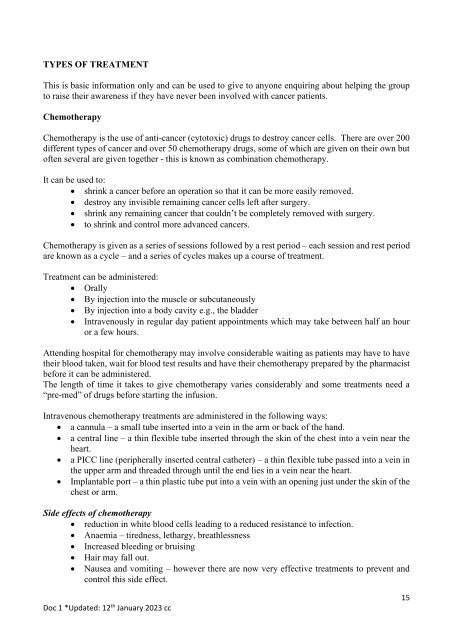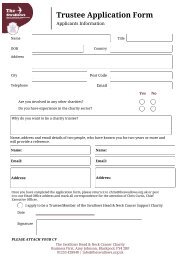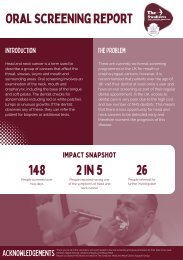1. Guidelines Best Practice 2023
This will help you the Patient/Caregiver lead with running the support group.
This will help you the Patient/Caregiver lead with running the support group.
You also want an ePaper? Increase the reach of your titles
YUMPU automatically turns print PDFs into web optimized ePapers that Google loves.
TYPES OF TREATMENT<br />
This is basic information only and can be used to give to anyone enquiring about helping the group<br />
to raise their awareness if they have never been involved with cancer patients.<br />
Chemotherapy<br />
Chemotherapy is the use of anti-cancer (cytotoxic) drugs to destroy cancer cells. There are over 200<br />
different types of cancer and over 50 chemotherapy drugs, some of which are given on their own but<br />
often several are given together - this is known as combination chemotherapy.<br />
It can be used to:<br />
• shrink a cancer before an operation so that it can be more easily removed.<br />
• destroy any invisible remaining cancer cells left after surgery.<br />
• shrink any remaining cancer that couldn’t be completely removed with surgery.<br />
• to shrink and control more advanced cancers.<br />
Chemotherapy is given as a series of sessions followed by a rest period – each session and rest period<br />
are known as a cycle – and a series of cycles makes up a course of treatment.<br />
Treatment can be administered:<br />
• Orally<br />
• By injection into the muscle or subcutaneously<br />
• By injection into a body cavity e.g., the bladder<br />
• Intravenously in regular day patient appointments which may take between half an hour<br />
or a few hours.<br />
Attending hospital for chemotherapy may involve considerable waiting as patients may have to have<br />
their blood taken, wait for blood test results and have their chemotherapy prepared by the pharmacist<br />
before it can be administered.<br />
The length of time it takes to give chemotherapy varies considerably and some treatments need a<br />
“pre-med” of drugs before starting the infusion.<br />
Intravenous chemotherapy treatments are administered in the following ways:<br />
• a cannula – a small tube inserted into a vein in the arm or back of the hand.<br />
• a central line – a thin flexible tube inserted through the skin of the chest into a vein near the<br />
heart.<br />
• a PICC line (peripherally inserted central catheter) – a thin flexible tube passed into a vein in<br />
the upper arm and threaded through until the end lies in a vein near the heart.<br />
• Implantable port – a thin plastic tube put into a vein with an opening just under the skin of the<br />
chest or arm.<br />
Side effects of chemotherapy<br />
• reduction in white blood cells leading to a reduced resistance to infection.<br />
• Anaemia – tiredness, lethargy, breathlessness<br />
• Increased bleeding or bruising<br />
• Hair may fall out.<br />
• Nausea and vomiting – however there are now very effective treatments to prevent and<br />
control this side effect.<br />
Doc 1 *Updated: 12 th January <strong>2023</strong> cc<br />
15
















